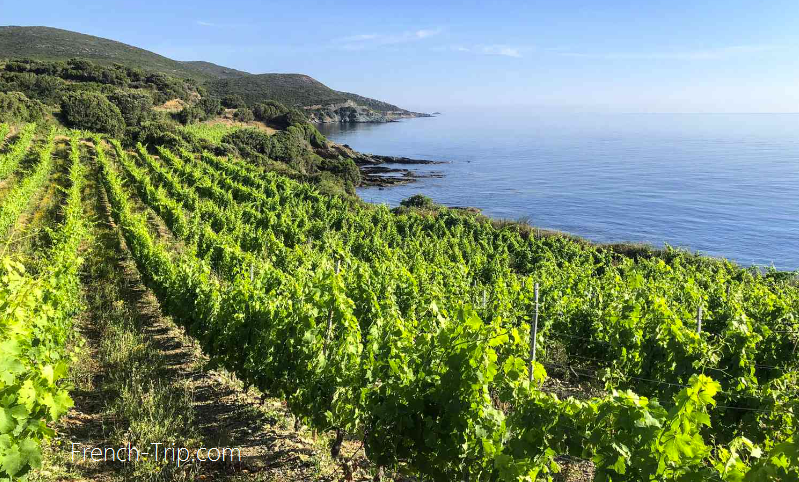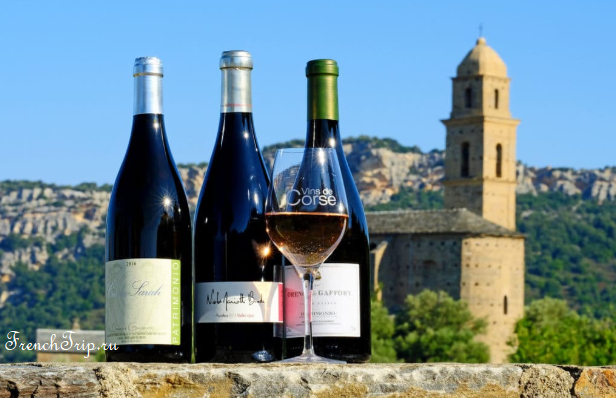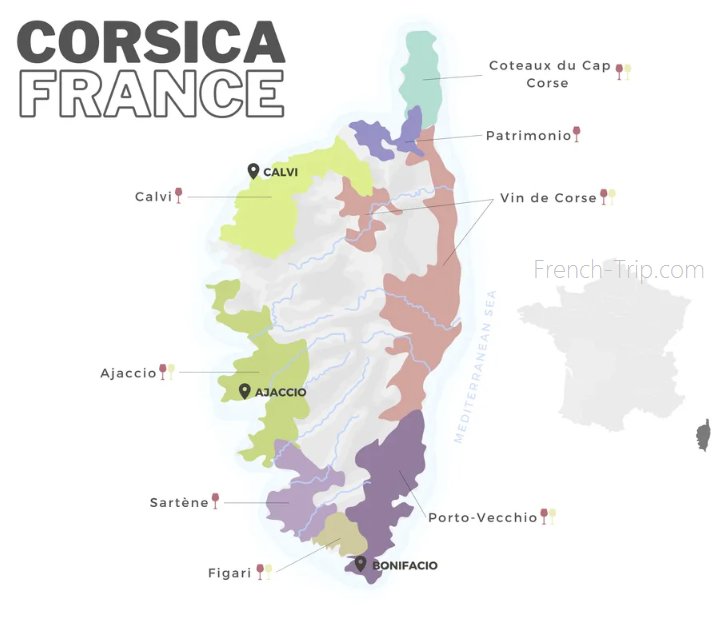Corsican wines

Corsican wines are produced on one of France’s most picturesque islands. Located 90 km west of Italy, 170 km southeast of France, and 11 km north of Sardinia, Corsica is a territorial collectivity of France. However, many of the region’s winemaking traditions and grape varieties have Italian origins.
The viticultural history of the region can be traced back to the settlement of the island by Phocaean traders in 570 BC at what is now the commune of Aleria. In the 18th century, the island came under French control. After Algeria gained independence from French rule, many Algerian Pieds-Noirs immigrated to Corsica and began planting vineyards. From 1960 to 1976, the vineyard area in Corsica quadrupled.
In 1968, Patrimonio was established as the first Appellation d’origine contrôlée (AOC). Today, Corsica has 9 regional AOC, including the island-wide designation Vin de Corse AOC. Much of the wine exported from Corsica falls under the Vin de Pays designation Vin de Pays de l’Île de Beauté (Country wine from the Island of Beauty). The three leading grape varieties of the region are Nielluccio, known as the spicy wine of France, Sciacarello, and Vermentino.

Corsica Wine
Wine Regions of Corsica:
- Vin des Coteaux-du-Cap-Corse
- Patrimonio
- Vin de Corse Calvi
- Vin de Corse
- Ajaccio
- Vin de Corse Porto-Vecchio
- Vin de Corse Sartène
- Vin de Corse Figari
Wine Regions of Corsica on the Map:
Geography and Climate of Corsica’s Vineyards:
Corsica is the most mountainous island in the Mediterranean. The climate here is warmer and drier than mainland France. During the peak growing month, the average temperature is 23.3°C. The average annual rainfall for most of Corsica’s wine regions is 730 mm, with 65 mm during the harvest month of September. Very little rain falls in August and September, allowing most harvests to be brought in without rot. On average, Corsica has about 2750 hours of sunlight per year, and the nearby sea absorbs most of the daytime heat and radiates it back to the island at night. This creates a more constant temperature and significantly reduces daily temperature fluctuations. The mountainous terrain creates several mesoclimates with varying degrees of altitude, latitude, and maritime influence.
There are several different types of soils. In the northern wine region, consisting of the Cap Corse peninsula, the soil is mainly schist. South of Cap Corse is the limestone-rich chalk and clay soil of the Patrimonio region. Along the western coast, the soil contains a high proportion of granite. Vineyards planted on the eastern coast of the island between the towns of Solenzara and Bastia are mainly on marl sand.

Wine Regions of Corsica
Corsica has 9 AOC regions and the Vin de Pays de l’Île de Beauté designation across the island, accounting for two-thirds of all wine production on the island. The Patrimonio area on the northern coast was the first to receive AOC designation, established in 1968. The large region around the island’s capital, Ajacco, includes some of the highest vineyards in Corsica. The general AOC Vin de Corse covers the entire island and includes smaller subregions:
- Vin de Corse-Coteaux du Cap Corse,
- Vin de Corse-Calvi,
- Vin de Corse-Figari,
- Vin de Corse-Porto Vecchio,
- Vin de Corse-Sartène AOC.
These subregions typically require lower yields than the Vin de Corse AOC. The Muscat du Cap Corse AOC includes naturally sweet Vin Doux wines produced in the northern part of the peninsula.
Patrimonio Wine Region:
The Patrimonio wine region is located on the northern coast of the island, west of the city of Bastia, on the chalky and clay soils around the town of Patrimonio. Nielluccio is the main grape variety and usually makes up to 95% of the AOC region’s red and rosé wines. The region’s white wines are often 100% Vermentino. In 2002, the region changed its AOC rules to require at least 90% of red wines and 75% of rosés to be made from Nielluccio, with Grenache, Sciacarello, and Vermentino allowed as additives. According to wine expert Tom Stevenson, wines from this region are typically best enjoyed within 1-3 years of harvest.
Ajacco Wine Region:
The Ajacco wine region includes vineyards surrounding the southwestern coastal city of Ajacco. The region produces mainly medium-bodied red and rosé wines, primarily from the Sciacarello grape. White wines from Ajaccio are often blends of Uni Blanc and Vermentino.
According to AOC regulations, red wines must contain at least 40% Sciacarello, which, along with Barbarossa, Nielluccio, and Vermentino, must make up at least 60% of the total blend. The remaining 40% can be from a mix of Grenache, Cinsault, and Carignan, with no more than 15% Carignan. Stevenson notes that these wines generally have a similar lifespan to wines from Patrimonio.

Vin de Corse:
This regional designation and its subregions account for about 45% of all AOC wines produced in Corsica. Red and rosé wines here must include at least 50% Nielluccio, Sciacarello, and Grenache. White wines are primarily Vermentino. This region includes many of Corsica’s oldest wineries, founded in the 1960s on the island’s eastern plains. Vin de Corse-Coteaux du Cap Corse, located at the northern tip of the peninsula, produces sweet wines from Muscat and Aleatico. Wines made from the latter are usually labeled as Rappu wine.
Vin de Corse-Calvi:
The subregion Vin de Corse-Calvi is located around the northwestern coastal town of Calvi, north of Ajaccio. Wines from this region must meet the same AOC standards as the larger Vin de Corse, with red and rosé wines containing at least 50% Grenache, Nielluccio, and Sciacarello, and no more than 50% of the combined blend of Barbarossa, Carignan, Cinsault, Mourvèdre, Syrah, and Vermentino. Carignan and Vermentino are included in the blend at no more than 20%.
White wines must contain at least 75% Vermentino, with Uni Blanc allowed in the blend.
Other Wines of Corsica:
The subregion Vin de Corse-Porto Vecchio is located on the southeastern coast around the town of Porto-Vecchio. The subregion Vin de Corse-Figari is located around the southwestern town of Figari, between Sartène and Porto-Vecchio. The subregion Vin de Corse-Sartène is located northwest of Figari, centered around the town of Sartène.
Around the communes of Figari and Sartène, several remaining vineyards of Bariadorgia/Carcajolo Blanc have survived.
Muscat du Cap Corse:
The Muscat du Cap Corse region mainly includes the northern tip of the peninsula and overlaps with the AOC Vin de Corse Coteaux du Cap Corse and five communes producing wines in the AOC Patrimonio. The sweet dessert wine from the Cap Corse region is produced in the Vin Doux Naturel style and is entirely made from Muscat Blanc à Petits Grains.
Related links:
- Wine from Ajaccio
- French Wines
- Classification of French Wines
- Wine Regions of France
- Cheese and Wine Pairing
- Wine and Food Pairing
- How to Pair Wine with Food
Archives
Calendar
| M | T | W | T | F | S | S |
|---|---|---|---|---|---|---|
| 1 | 2 | 3 | 4 | |||
| 5 | 6 | 7 | 8 | 9 | 10 | 11 |
| 12 | 13 | 14 | 15 | 16 | 17 | 18 |
| 19 | 20 | 21 | 22 | 23 | 24 | 25 |
| 26 | 27 | 28 | 29 | 30 | 31 | |

